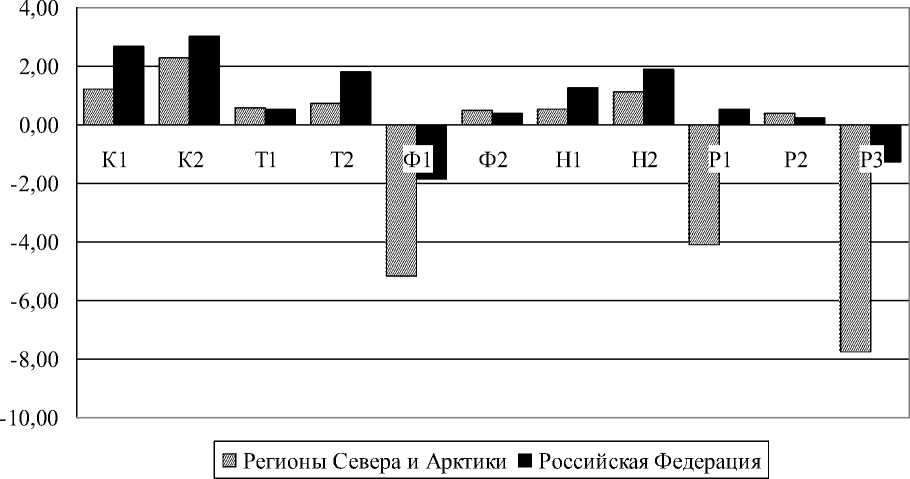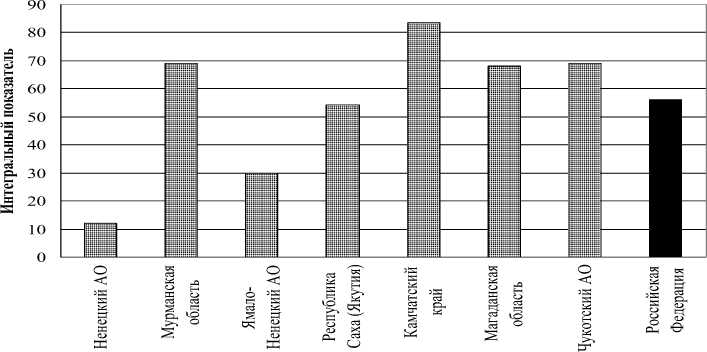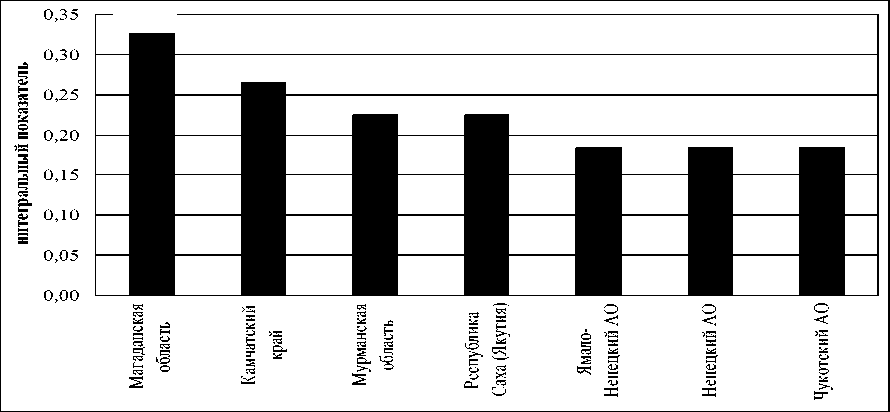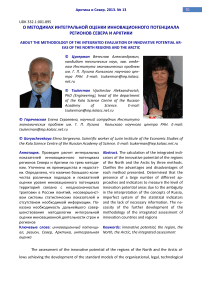About the methodology of the integrated evalu-ation of the innovative potential areas of the North regions and the Arctic
Автор: Tsukerman V.A., Goryachevskaya E.S.
Журнал: Arctic and North @arctic-and-north
Рубрика: Regionology of the Arctic and North: Management, Economy, Sozium, Culture
Статья в выпуске: 13, 2013 года.
Бесплатный доступ
The calculation of the integrated indicators of the innovative potential of the regions of the North and the Arctic by three methods. Clarifies the advantages and disadvantages of each method presented. Determined that the presence of a large number of different approaches and indicators to measure the level of innovation potential areas due to the ambiguity in the interpretation of the concepts of Russia, imperfect system of the statistical indicators and the lack of necessary information. The necessity of the further development of the methodology of the integrated assessment of innovation countries and regions.
Innovative potential, the region, the North, the Arctic, the integrated assessment
Короткий адрес: https://sciup.org/148319889
IDR: 148319889 | УДК: 332.1:001.895
Текст научной статьи About the methodology of the integrated evalu-ation of the innovative potential areas of the North regions and the Arctic
The assessment of the innovative potential of the regions of the North and the Arctic allows achieving the development of the standard models of the organizational, legal, technological innovation formation process, taking into the account sectoral and regional specificities. Objective evaluation of the innovation capacity will consolidate on the innovative capability field enterprises, regional and federal authorities, as well as it will allow eliminating the resulting congestion in the use of thescientific and technical developments, inventions, know-how.
There are many definitions of the innovation potential:
-
1. Innovative potential – is a collection of the different types of the resources required to implement innovations [1]. In this case, the structure of the innovation potential is defined as the unity of its three components: resources, internal and productive, which coexist mutually, suggest and cause each other and are shown using his triune nature.
-
2. The potential for the innovation is to mean the amount of the economic resources, which at any given society can be used for its development. These resources are distributed between the three main sectors (segments, lines) macrosystem: scientific, technical, educational, investment. The totality of these segments and generates innovative potential macro system [2].
-
3. The innovative potential of the regional socio-economic system – is a set of the resource capabilities, technological, commercial, managerial skills to generate, disseminate and use innovations to modernize the economy of the region [3].
Meaning of the North and the Arctic in Russian's economic development is due mainly explored and prospective mineral resources located on its territory. It focused two thirds of the resource potential of the country, including more than half of the forest, fish, furs, diamonds mined 100%, 80% gold, more than 90% natural gas, 75% oil, which provide more than 60% of the foreign exchange earnings. There is about 8% of Russian’s population, but produces about 20% of the gross domestic product [4].
In this paper, to assess the innovative capacity of the North and Arctic regions have been used three methods: 1) an innovative profile, 2) positioning of the region, and 3) clustering regions and consideration of three groups of indicators FIG. Methods of calculating the profile developed innovative OS Moskvina [5]. In accordance with this procedure, the estimated aggregated characteristics of the innovation potential (Table 1).
Table 1
|
Group of Indicators |
Indicator |
Symbol index |
Border characteristic of the indicator |
|
|
R |
Z |
|||
|
Manpower component |
proportion of workers with higher education in total employment,% |
К1 |
0,25 |
0,8 |
|
Number of the students in theeducational institutions of the higher education in the 10 thousand people |
К2 |
100 |
150 |
|
|
technological component |
Depreciation of fixed assets,% |
Т1 |
60 |
25 |
|
Specific gravity completely depreciated assets as a% of total fixed assets activity |
Т2 |
12 |
8 |
|
|
financial component |
Gross domestic expenditure on research and development to GRP,% |
Ф1 |
2,5 |
5 |
|
Investments in fixed capital to GRP,% |
Ф2 |
12 |
59 |
|
|
scientific component |
Number of personnel performing R & D by 10 thousand people. population |
Н1 |
13 |
40 |
|
Number of the researchers with advanced degrees to 10 thousand people. population |
Н2 |
0,4 |
4,0 |
|
|
The result of the companent |
The number of patent applications per 10 thousand people. population |
Р1 |
2,5 |
5 |
|
Innovative activity of organizations,% |
Р2 |
40 |
10 |
|
|
The volume of innovative products, works and services in% of the total shipped goods, works, services |
РЗ |
8 |
15 |
|
The system of the general indicators characterizing innovation potential
The resulting general indicator of the potential graphically displayed in the form of the innovative profile of the North and Arctic regions (Fig. 1). The calculations allow identifying and ranking the most problematic factors for the complex innovative development of the northern regions and the Arctic.
Positive is basically personnel and the scientific components, as well as technical and technological. At the same time, despite the fact that in the recent years there is a constant increase in the share of the investment in the fixed assets to GRP (F2), their scientific component (F1) is in the area of the unsatisfactory state. In the personnel area swept gradual rise in the educational level of the workers (K1) due to the positive dynamics of the indicators characterizing training (K2).
Performance indicators in the area of the block are unsatisfactory condition. That is the innovative potential and as ability and readiness can be described as insufficient for the formation of the active innovation economy.

Piс. 1. Innovative profile of the North and Arctic regions
To implement this technique requires a number of the issues, including the choice of the indicators characterizing innovation potential, determine boundary characteristics selected indicators, the analysis of the regulatory and actual indicators. The disadvantage should be noted that its use is limited to the scope of a given region, and does not provide a comparative description of others. Based on a report E. Bykov and M. Youngster [6] has developed a system of the indicators characterizing the state of knowledge economy in the region in the evolving knowledge economy in Russia (Table 2).
Table 2
Scale for the positioning the North and the Arctic regions for the innovative development
|
Indicators |
Categories |
Indexes |
|
incoming indicators Expenditure on innovation |
Human resources |
Number of personnel engaged in research and development, per 10 thousand people |
|
Number of the students in the educational institutions of the higher education per 10 thousand people |
||
|
Number of the researchers with advanced degrees per 10 thousand people in the region |
||
|
Creation of Knowledge |
Gross domestic expenditure on the research and development as a% of VPP |
|
|
Transmission and application of knowledge |
Innovative activity of organizations,% |
|
|
The number of organizations engaged in research and development in the total number of organizations in% |
|
Expenditure on technological innovation in the volume of innovative products, works and services,% |
||
|
The share of the organization used information and communication technologies in the total number of surveyed organizations |
||
|
outgoing indicators The result of Innovations |
Yield market, intellectual property, application of knowledge |
Technology exports as a% of the region's total exports to the regional |
|
Filed patent applications for personnel involved ments of research and development,% |
||
|
The share of the organization that had a web site, the total number of surveyed organizations,% |
||
|
The volume of innovative products, works and services as a percentage of the total volume of goods shipped, do the job, services |
Potential value of each indicator (Ii) scored on a scale from 0 to unity in order to get rid of the dimension, and it is calculated as follows (1): I xi xmin (1), where xi – is the actual value xmax xmin of the indicator in the i-th year; xmax (min) maximum (minimum) value of the indicator in the i-th year. Final regional innovation index is calculated as the average ratings of all indicators (2):
n
I I i
SII i 1
n where n – is the number of the indicators included in the SII. Thus, all the indicators included in the index with the same weights.
Figure 2 shows the results of ranking North and Arctic regions.

Pic. 2. Integral indicators of the innovative development and positioning the North and the Arctic regions
Technique based positioning indices obtained the primary indicators and has its advantages and disadvantages. The advantages include the relative ease of the calculation: index build innovative capacity does not require the complex and time-consuming work, and the amount of the required statistical data is limited to one year. In addition, the Innovation Index reveals disparities in the development of the innovation territorial entities, as estimated set of both incoming and outgoing indicators.
However, the technique has certain disadvantages because of its analytical possibilities are limited only by comparison between regions within the same year. With the index difficult to identify long-term trends in the innovative development or make a prediction, and determine why some regions are more successful in the creating innovation than others.
On the basis of [7] assessed the innovative capacity and the classification of the North and Arctic regions of Russia in the terms of the innovative capacity. For an integrated assessment of all selected indicators used the method scores. Entering the region in the first group-specific Metrics is worth 3 points, the second - 2, in the third - 1. When calculating the integral index (average score) estimates were made with the same densities, ie assumed equivalence of their impact on the innovative capacity of the region. The result is a cumulative assessment of the innovative potential of the regions of the North and the Arctic of the method based on clustering of the regions and considering three groups of the indicators RIS (Fig. 3).

Pic. 3. Integral assessment of the innovative potential of the regions of the North and the Arctic
Clustering technique and regions considering three groups of indicators RIS has its advantages and disadvantages. Disadvantages methods: 1) the ranking of the North and Arctic regions in three groups performed on the basis of the performance indicators, which are defined by experts; 2) the calculation of the integral index of all estimates are taken from the same densities. Advantages of the technique: simple calculations.
The large number of the different approaches and indicators to measure the level of innovation potential areas associated primarily with the ambiguity tractor reparation in Russia con- cepts not only "innovation potential", but "innovation", "innovation activities", "regional innovation system" etc. This is due to the lack of the federal regulations "On Innovations and Innovation", "On state support of innovation activity in the Russian Federation", and, consequently, legislated basic terms of the innovation policy. Necessary legislative generalization and refinement of the conceptual apparatus in the innovational field and convergence of the common terms in Russia and abroad.
In addition, measurement of the innovation potential due to imperfection of the statistical indicators and the lack of adequate information. For objective assessment of the innovative potential of the North and Arctic regions further research is needed in the direction of improving the methodology.
Improving research methodology innovation sphere is an incentive to the development of the international standards of the innovation statistics. However, the foreign researchers have noted deficiencies in the current system for the collecting statistical information at the national and regional levels [6].
Misrepresentation also occurs at the level of the individual firm, due to certain requirements for the accounting standards and taxation system that does not promote reflection of intangible assets of the firm, their accounting and management. Despite the fact that the international accounting system provide great opportunities on intangible assets as compared to Russian norms, leading financial advisors developed countries point to the urgent need to revise the standards for the provision of information on intangible assets, both within the firm and the capital markets [8].
Necessary to ensure the development of the innovative development of the statistics. A similar conclusion is drawn in the "Strategy for the Development of Science and Innovation in the Russian Federation for the period till 2015" [9]. Basic guidelines for ensuring the development of the statistical indicators in the field of the science and innovations:
-
1. Analysis of the state-level implementation of the priority directions of the science, technology and engineering.
-
2. Analyze the state-level development and use of the logistical and experimental base of science, including an assessment of the availability and the technical level of the costly machinery and equipment, the age structure of the technical equipment, condition and use of the pilot plants, the development of the forms of the collective use of the scientific equipment, availability and use of land, unique research facilities, buildings.
-
3. Establishing a system evaluation and monitoring business performance industry, including the harmonized system of the statistical indicators comparable with accepted international practice, tools statistical observations and recommendations on the implementation of the assessment procedures in the practice of the business and government.
-
4. Development of the methodology and organization of the monitoring creation and the use of the critical technologies, including formation of the critical technologies and classification of the products (services) produced using them, scorecards, and survey instruments.
-
5. The formation of a statistical observation of the development of the internal market for technology (involving research and development results in the economic cycle, the development of a license exchange, etc.).
-
6. Updated program of the statistical surveys of the innovation in the coordination with leading international organizations, the next round of European innovation surveys, which will expand the existing framework for quantitative and qualitative measurement of the innovation processes in the several areas related to coverage of a wider range of the innovations (including marketing and organizational), the structuring of the innovation enterprises by the type of the innovation, research and cooperative ties, etc.
-
7. Development of the methodology and organization of the monitoring innovation infrastructure, including an assessment of the resource base and the effectiveness of the activities related to the commercialization of the results of the research and development, the provision of other services of an intellectual nature, based on a combination of the statistical reporting and one-time surveys (including the sample).
-
8. Development of the methodological approaches to measuring venture capital, taking into account the various forms of the venture capital financing, the assessment of the structure of assets and venture capital funds, uses of funds, including supporting innovative projects and companies in the early stages.
-
9. The organization of the monitoring of the small business innovation (through the creation of the systems for the collecting, processing and the presentation of the statistical information that adequately reflects the main trends in the development of the innovative activity of small enterprises), which should aim to provide for the formation of thpanels of the most active in the terms of the innovative small businesses with sustainable partnerships in this sphere, using both statistical and sociological tools for in-depth analysis of the results of their innovation.
-
10. Statistical analysis of the innovation clusters, including the analysis of the development of the existing clusters (in particular, special economic zones and science cities) and the identification of the areas with substantial scientific and technical potential and innovative in the terms of opportunities to reach global markets high-tech products.
-
11. Development of the methodology and organization of the statistical observation of the production and sale of high-tech products (including exports). Particular attention should be given to methods of assessing knowledge-intensive economic activities, products (services) and group them into relevant categories (high, medium, low-tech).
Список литературы About the methodology of the integrated evalu-ation of the innovative potential areas of the North regions and the Arctic
- Кравченко С. И., Кладченко И. С. Исследование сущности инновационного потенциала // Научные труды Донецкого технического университета. Серия: Экономика. Донецк: ДонНГУ. 2003. С. 88—96.
- Жиц Г. И. Инновационный потенциал и экономический рост. Саратов: Саратовский государственный технический университет. 2000. 164 с.
- Митрофанова И. В., Бендь А. С. Инновационный потенциал региона: проблемы формирования и использования // Сборник материалов международной научнопрактической конференции «Управление инновациями». Москва: Изд-во «Доброе слово». 2006. С. 186—189.
- Ларченко Л. В. Государственное регулирование развития ресурсодобывающих регионов российского Севера: дис… доктора эконом.наук: 08.00.05. Санкт-Петербург. 2005. 326 с.
- Москвина О. С. Инновационный потенциал как фактор устойчивого развития региона [Электронный ресурс]. URL: http// www.vsca.ac.ru/newsite/jon/30/agt 30 02 plip (дата обращения: 13.01.2010).
- Быкова А. А., Молодчик М. А. Проблемы позиционирования региона в новой экономике // Инновации. 2007. № 1. С. 66—79.
- Инновационный путь развития для новой России / Отв. ред. В. П. Горегляд; Центр социально-экономических проблем федерализма Института экономики РАН. М.: Наука, 2005. 343 с.
- Лев Б. Нематериальные активы: управление, измерение, отчетность / Пер. с англ. Л.И. Лопатникова. М.: Квинто-Консалтинг. 2003. 240 с.
- Стратегия развития науки и инноваций в Российской Федерации на период до 2015 года [Электронный ресурс]. URL: http://www.smi-svoi.ru/content/print.asp?sn=1181 (дата обращения: 28.04.2009).


